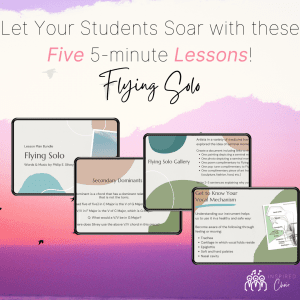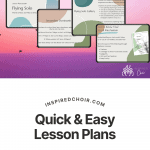When Emotion Meets Power: An In-Depth Guide to Philip Silvey’s Flying Solo
If you are looking for a touching and inspiring piece with beautiful harmonies and killer emotional release, Philip E. Silvey’s Flying Solo needs to be on your radar. Available for SATB, SSA, and TBB Ensembles, this piece is a singer favorite for all the right reasons. Below is an in-depth guide to Flying Solo including:
- Flex Those Social and Emotional Muscles with Flying Solo
- Voice Mapping in Flying Solo
- Making Choices in Flying Solo
- Get into the Music Theory supporting Flying Solo
- Flying Solo Teacher Resources
- …and so much more!
Some of the links below are affiliate links. This means that, at zero additional cost to you, I will earn an affiliate commission if you click through the link and finalize a purchase.
A Quick Favorite
In the early Spring of 2022, our Bass ensemble took a hit in numbers due to new class schedules at the start of the semester. The students remaining were talented and incredibly eager, so I wasn’t too concerned. Honestly, I was excited to see what singers might rise up as leaders in their sections when presented the opportunity.
I had already chosen a few TTBB pieces, and knew that with our new smaller numbers, I needed a 3-part piece that would allow the singers to feel successful quickly at the start of the semester. Enter Philip Silvey’s Flying Solo.
I ordered the piece late, so we didn’t have it until our third or fourth rehearsal. I wanted to get the piece in their ear, so in one of our early rehearsals, I played this recording for the singers. The first verse pulled them in, the refrain peaked their interest more, and as soon as they heard the bridge of Ah’s at letter E, the ensemble was completely sold on the piece.
As soon as the music arrived, we dug in and learned the piece quickly. Together, the compelling melodies and harmonies, driving accompaniment, and captivating dynamic contrasts built to a beautiful emotional release throughout the piece.
Listen to the Arkansas State Spring 2022 Singing Statesmen’s performance of Flying Solo here. Serious props to our accompanist, Dr. Bryan Chuan. The piano for this piece is no joke!

Leaving the Nest with Flying Solo
For our choir, Flying Solo was a quick learn, which gave us time to connect to the text, explore the use of our vocal mechanisms, experiment with musical choices, and flex our music theory skills.
Social Emotional Learning and Flying Solo
A focus on Social Emotional Learning (SEL) in choir allows singers of all ages an opportunity to mindfully examine the ways in which they and their singing colleagues recognize and manage their emotions and make decisions in and out of choir. See my recent article in the Choral Journal for more information on the benefits of embedding social emotional learning in everyday choral interactions.
Composer Philip Silvey is a big proponent of Social Emotional Learning. This past year, he has composed several pieces for Hal Leonard’s Voices in Harmony series. Each piece in this series includes videos and teaching resources to help instructors address social and emotional learning with their ensembles.
Although Flying Solo is not part of this series, its text and influence lends itself well to SEL-influenced discussions. In his introduction to the piece, the author describes his experience of watching a baby bird leave the nest for the first time. This observation prompted him to write Flying Solo for individuals who gathering the courage to embark on a new stage of life.
SEL-Inspired Conversations
Below are a few discussion prompts that could help address the five core SEL competencies:
| SEL Competency: | Discussion Prompts: |
|---|---|
| Self-Awareness | When have you experienced a leap from one stage of life to the next? How did you feel before you made this transition? After? How do those emotions translate to your interpretation of Flying Solo? |
| Self-Management | What strategies do you have to regulate your emotions as you embark on transitional moments in your life? How might these strategies apply to your self as a musician? |
| Decision Making | As you sing Flying Solo, what musical decisions can you make to share with your audience the emotions associated with embarking on a new stage of life? |
| Social Awareness | Are you aware of anyone in your choir (or in your life in general) who is dealing with a major life transition? What signs might they display to indicate that they are approaching a new stage in life? |
| Relationship Skills | How do you maintain relationships throughout transitions in your life? Or how can you support a friend or colleague who is going through a transition of their own? |
If you want to know more about Social Emotional Learning, I encourage you to check out the books linked below. These are some of my favorites!
Map that Voice!
Flying Solo asks for a lot from its singers dynamically. The ranges are reasonable, and generally comfortable, but man is it easy to fall into a blast-y sound as you reach the climax of this piece. A general knowledge of the vocal mechanism can help us approach those emotionally charged loud sections in a safe and healthy way.

At the beginning of each semester, I like to review the anatomy of the vocal mechanism with my ensembles. As we study images of the mechanism, we map out our own mechanisms through feeling or envisioning the anatomy in our own bodies.
Flying Solo requires a lot of vocal power. The tricky part about singing with power is keeping it safe, healthy, and free. With our body maps created or updated, the ensemble and I were able to talk about the mechanics of singing with power: creating space by raising the soft palate and opening the throat; relaxing the muscles surrounding the larynx; engaging the air by utilizing core muscles; setting up the best posture for our resonators.
Laurel Irene and David Harris at VoiceScienceWorks have created an abundance of free and accessible educational resources for singers. I especially like their vocology toolbox, SOVT exercises, and voice science for kids resource.

Independent Musicianship – Making Choices
Within the text of Flying Solo, the speaker talks about making choices, taking the lead, and using their knowledge and momentum to make decisions on their own. All too often in choral settings, singers are required to follow without room for creativity or ownership. But what happens if singers are allowed to use their knowledge and experiences to make their own musical choices?
In my experience, if an ensemble decides together how they want to stress a word or pronounce a syllable or phrase a line, they feel more ownership in the process and the product. For me, often times that means providing the singers with options: Should we do A or B? Then we can try each option and examine the effect each option creates and decide which we prefer.
A few examples of choice the ensemble could make in Flying Solo:
- At letter A, what does the instruction “Resolutely” mean for our phrasing and articulation?
- In measures 14 and 15, how short do we want the eighth notes to be? Why?
- Throughout letter E, how quickly to we want to crescendo and decrescendo? What effect do different speeds have upon the overall aesthetic?
- How much do we want to rit. at measure 87? Why?
Let’s Get Into the Theory!
Lending to the emotional engagement of Flying Solo is Silvey’s clever compositional style. The rhythmic energy is out of control (more on sixteenth note rhythms in this post), but the shifting tonal centers make this composition. To understand these shifting tonal centers, we’ll have to get into some second-semester music theory information.
As we analyze the tonal centers of this piece, the following ideas will be helpful:
- In Western music theory, each scale degree has a function. So, in a C major scale, C is the tonic (I), D is the sub-mediant (ii), E is the mediant (iii), F is the sub-dominant (IV), G is the dominant (V), A is the submediant (vi), and B is the sub tonic or leading tone (viio).
- Each Major key has a Relative Minor. These keys share the same key signature (like relatives share the same last name). So C Major (no sharps or flats) has a relative minor of a minor.
- Each Major key also has a Parallel minor. These keys share the same tonic (starting note). So C Major’s (no sharps or flats) parallel minor is c minor (Bb, Eb, Ab)
- Secondary Dominant: a chord that has a dominant relationship with a chord that is not the tonic. So a V/V (read five of five) in C Major is the V of G Major, which is D Major.
- Picardy Third: a major chord at the end of a piece or section in a minor key.
Analyzing Flying Solo
We begin the piece in d minor. We know that we are in d minor because we have one flat (Bb) in our key signature, which means we are either in F Major or its relative, d minor and we start with a nice d minor chord in the piano. This lasts for the first few pages.
However, once we get to letter B, we notice some repeating accidentals (F#s and B♮s), indicating a key shift. The tonality shifts to a minor for four measures (IV-v-i), then to Bb Major for four measures (V-I), then finally back to d minor. This pattern repeats itself in letters C and D.
Then, at Letter E, we see some C#s, F#s, and B♮s appear, indicating another shifting tonal center. This time, we move into the key of G Major with the appearance of a secondary dominant chord (V/V-IV-I-V), before we settle back in to d minor until our last D Major chord: a picardy third with a 9th.
It’s common for Western composers to shift keys to the parallel key or relative key, and explore dominant and sub-dominant relationships within these keys. a minor is d minor’s dominant; Bb Major is d minor’s relative key F Major’s sub-dominant; and G Major is d minor’s sub-dominant. (Does your head hurt yet?)

But…Why?
Why does any of this matter? Well first, it helps us appreciate the work that the composer has done to create this piece. Second, it helps us build enduring understandings that we could perhaps bring to compositions of our own down the road. Sometimes composition is a puzzle, and music theory is our key. Finally, and maybe most importantly, with this knowledge we can begin to examine what it is about certain elements of choral music that inspire us to feel certain ways.
I have to be honest. Music theory like this makes my head spin sometimes. Major credit to my friend and colleague Dr. Derek Jenkins for his guidance on this analysis.
Complementary Pieces
What to listen to or program additional choral music about Transitions?
- Miriam Sonstenes’ I Am Leaving reflects simply and yet profoundly on how relationships are impacted through transitions.
- Ysaye M. Barnwell’s Wanting Memories is sung from the perspective of someone who was left behind in a transition.
- Brandon Waddles’ arrangement of On My Journey Now comes from the perspective of someone who is currently on the journey of embarking on a new stage of their life.
Feeling a Flying Theme?
- Eric Whitacre’s Fly to Paradise is such a cool piece with an electronic backing track! I’m itching to find an opportunity to program this.
- Ed Lojeski’s arrangement of contemporary country/pop duo Maddie and Tae’s Fly is a cute country piece that could serve nicely as a graduation song.
- Kim Andre Arnesen’s Flight Song is one of those pieces that just feels good to listen to and sing!
- Pink Zebra’s Fly Away Home asks singers to consider the concept of “home” and opens up opportunities to build home within choir.
I’d Love to Hear from You!
Have you sung or conducted Flying Solo with your choir? How did your ensemble react to the piece? What stories of transitions or starting off on adventure does Flying Solo evoke for you? Let me know about your experiences with Flying Solo in the comments below!
Flying Solo Teacher Resources
Free Comprehension Worksheets
Choir Leaders! I have begun to include short comprehension worksheets with each Inspired Choir blog post. Each worksheet includes 5-6 knowledge-based questions about the post and concludes with a musical decisions/applications question. Use as a homework assignment, sub activity, listening challenge, or guide for conversation in class. Fill in the form below to receive a link immediately to all “Roots” Worksheets.
Flying Solo Lesson Plan Bundle
Check out the Inspired Choir Shop for the Flying Solo Lesson Plan Bundle. This bundle includes the following five minute lesson plans, all with connections to National Standards and SEL Competencies:
- SEL-Influenced Discussion Prompts
- Vocal Mechanism Discovery Exercise
- Independent Musicianship Assignment
- Interdisciplinary Flying Solo Project
- Tonal Centers Music Theory Lesson





















